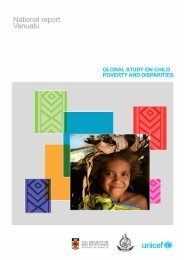A Strategic Assessment of the Children's Services Industry
A Strategic Assessment of the Children's Services Industry
A Strategic Assessment of the Children's Services Industry
- No tags were found...
You also want an ePaper? Increase the reach of your titles
YUMPU automatically turns print PDFs into web optimized ePapers that Google loves.
STRATEGIC ASSESSMENT OF THE CHILDREN’S SERVICES INDUSTRYMobile Preschool 9A new initiative in <strong>the</strong> remote north-east <strong>of</strong> <strong>the</strong> Nor<strong>the</strong>rn Territory (NT) is <strong>the</strong> establishment,currently as a pilot project, <strong>of</strong> a mobile preschool service. Prior to mid-2002, preschool-agedchildren in many remote communities <strong>of</strong> NE Arnhemland had no access to preschoolprogrammes. As well, <strong>the</strong> remote Yirrkala community school lost its preschool teacher whenstudent numbers dwindled. The former stand-alone child care service had been providingchild care only, and <strong>the</strong> Department <strong>of</strong> Health and Community <strong>Services</strong> wanted <strong>the</strong> centre tobe more focused on early childhood education. Hence, <strong>the</strong> preschool <strong>the</strong>re joined with <strong>the</strong>existing child care centre to become an innovative child care centre with preschool. WithYirrkala being just one <strong>of</strong> several communities supported by <strong>the</strong> Mobile Preschool PilotProgramme (MPPP), <strong>the</strong> teacher could be <strong>the</strong>re only one day per week to support <strong>the</strong>preschool programme to be delivered by <strong>the</strong> MPPP assistant. This arrangement allowed <strong>the</strong>child care centre to become more oriented to community and early childhood education, andalso made it possible for preschool sessions to be held each morning. Delivery <strong>of</strong> <strong>the</strong>preschool programme within <strong>the</strong> child care centre has extended <strong>the</strong> programme for all <strong>the</strong>children in <strong>the</strong> centre, as well as involving more mo<strong>the</strong>rs as <strong>the</strong>y interact with <strong>the</strong> children in<strong>the</strong> activities.During this time, Commonwealth funding through <strong>the</strong> National Indigenous English Literacyand Numeracy Strategy (NIELNS) became available to increase <strong>the</strong> proportion <strong>of</strong> Indigenous3 to 5 year olds in preschool education. This funding source allowed <strong>the</strong> planning and piloting<strong>of</strong> a mobile preschool model. Jan O’Shea was appointed as <strong>the</strong> mobile preschool teacher with<strong>the</strong> responsibility <strong>of</strong> resourcing and supporting outlying remote preschools. Jan’squalifications are in primary and special education, specialising in hearing impairment, andshe has worked for many years in <strong>the</strong> Arnhem region. She considers that knowing many <strong>of</strong><strong>the</strong> children and parents <strong>the</strong>re before <strong>the</strong> project started has helped her to engage with <strong>the</strong>communities, to employ appropriate ‘teachers’ (mostly mo<strong>the</strong>rs or grandmo<strong>the</strong>rs) and to get<strong>the</strong> mobile preschool programme started. She now visits <strong>the</strong> Yirrkala Innovative Child carecentre / preschool once per week on Monday morning and <strong>the</strong>n on Friday, at a time suitablefor <strong>the</strong> staff, when <strong>the</strong>y work toge<strong>the</strong>r to develop <strong>the</strong> following week’s programme.The facility in Yirrkala is great for children. Under child care funding, all <strong>the</strong> children getmorning tea and lunch, paid for partly by <strong>the</strong> local ASSPA (Aboriginal Student Support andParent Awareness) committee. ASSPA funding can be accessed by schools for excursions andtutoring, and for breakfast and lunch programmes. At Yirrkala, <strong>the</strong> ASSPA group helps t<strong>of</strong>und <strong>the</strong>se aspects <strong>of</strong> <strong>the</strong> preschool programme and so facilitates <strong>the</strong> successful merging <strong>of</strong> <strong>the</strong>preschool with <strong>the</strong> child care service. The relatively new building has all sorts <strong>of</strong> equipmentincluding climbing frames, a sandpit, push bikes, and play equipment such as paints, paper,puzzles, books, games and construction materials. Most <strong>of</strong> <strong>the</strong> children’s parents come fromless than one kilometre away. Most <strong>of</strong> <strong>the</strong> preschool children travel to <strong>the</strong> centre on a buswhich drives around <strong>the</strong> community, first picking up <strong>the</strong> teacher, <strong>the</strong>n <strong>the</strong> children and somemo<strong>the</strong>rs who may accompany <strong>the</strong>m.There is a fair amount <strong>of</strong> parental involvement in <strong>the</strong> preschools as about 1/3 or 1/4 <strong>of</strong>children have <strong>the</strong>ir mo<strong>the</strong>rs or aunties present, with most getting involved in <strong>the</strong> activities. Janherself speaks little <strong>of</strong> <strong>the</strong> children’s language, but <strong>the</strong> teacher who is <strong>the</strong> prime deliverer <strong>of</strong><strong>the</strong> programme does, as do <strong>the</strong> mo<strong>the</strong>rs, aunties and o<strong>the</strong>r family members who are involved.9 Source: Secretariat for National Aboriginal and Islander Child care and Centre for Community Child Health,2004.57
















